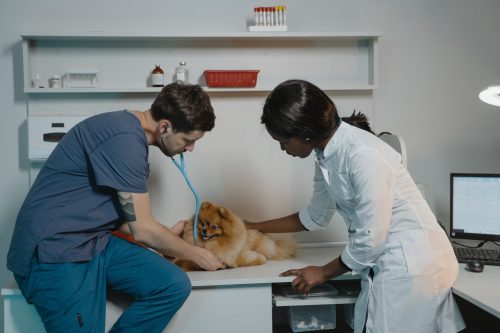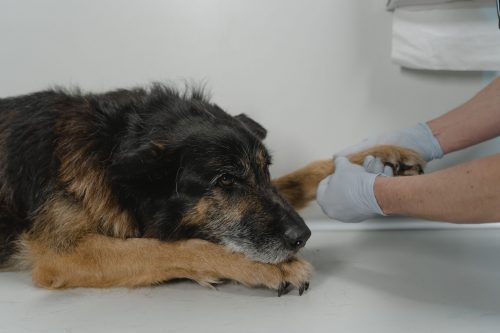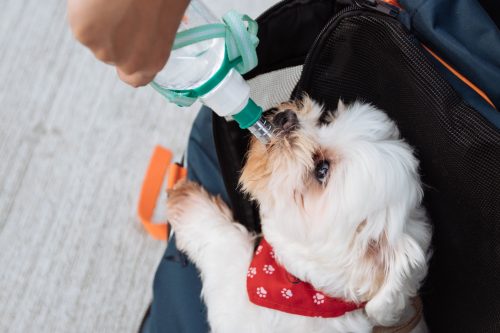It can be difficult to know when a family dog isn’t in perfect health. It is easy to miss conditions that require a veterinarian visit if we do not routinely check our pooches. “Should I take my dog to the vet?” you might ask. Here are some symptoms to look out for.
Irregular Appetite
Dogs have lots of appetite and interest in food so any irregular eating or loss of appetite in your pet is a red flag and is worth noting. Both can be a sign of mouth injury or illness. Don’t hesitate to get your dog to the veterinarian if they skip food and the water bowl for a day or two.

At times, illnesses and diseases can also trigger unusual eating habits in dogs. If you notice that your well-behaved dog is skipping food but raiding the garbage or pantry, take them to the vet for proper care. Some types of medicine may also be the cause and your veterinarian can advise you further.
Vomiting
It’s not unusual to see dogs vomit occasionally. If your dog vomits one or two times in a day and you don’t notice anything unusual about its health or behavior, this may not be a serious concern. It could be that your dog just has a stomach upset.
However, if your dog continues to vomit frequently, it can be a sign of something more serious. You need to visit the veterinarian immediately. Dogs may vomit if they have a fever. Sometimes, severe vomiting in dogs may lead to dehydration or diarrhea, so seek treatment immediately for your vomiting dog to ensure it doesn’t become dehydrated.
You should also visit the veterinarian immediately if it vomits blood or vomits frequently or many times in a row.
Unusual Stool and Urine
Pets’ stool and urine are a good indicator of their overall health. If your dog is healthy, its stool should be small, firm, and moist. Dry and hard stools may be a sign of dehydration, dietary problem, or health problem.

Though changing your dog’s toilet may lead to an increase in amounts or changes in color and frequency of urine or feces, get your dog to the veterinarian if you notice the following problems:
- Struggling or straining to urinate or defecate
- Urinating more often or in unusual places
- There is blood or mucus in the urine or feces
- There is a worm in the stool
- There is diarrhea for more than 24 hours
Fatigue or Lethargy
Fatigue or lethargy is a sign that your dog is troubled with pain, infections, or a variety of diseases, which include heart disease.
A lethargic dog would not be interested in playing, participating in any activity, or going for a walk. Fatigue or lethargy can sometimes be a result of high temperatures. However, if it’s combined with other symptoms, such as difficulty breathing, stooling, vomiting, and many more, you need to get your dog to the vet, especially if these persist for over two days.
Weight Loss
This indicates serious health concerns, especially if it’s sudden or unexpected. Sudden or unexpected weight loss should prompt you to visit a vet. If you notice a drop in weight in your dog by about 10%, the main thing to do is to seek immediate professional attention.

Red Eyes
This is an indication of an injury or infection. When you notice that your dog has red eyes, visit the veterinarian as soon as possible. Also, if you notice squinting, cloudy eyes, or excessive eye discharge, get your dog to the emergency vet clinic for a check up immediately.
Diseases or infections that affect the eyes may eventually cause blindness. However, immediate medication can help in curing the disease or infection and preventing further problems.etimes be a result of high temperatures. However, if it’s combined with other symptoms, such as difficulty breathing, stooling, vomiting, and many more, you need to get your dog to the vet, especially if these persist for over two days.
Change in Coat
A normal dog or puppy should have a thick, shiny, and soft coat. Anything contrary to this means something isn’t right. For example, if your dog develops a dull, rough, dry coat or has bald patches on the skin, take it to the veterinarian.

Change in coat could be as a result of skin disease, an allergy, or eating the wrong food. Whatever the culprit is, taking your dog to the veterinarian is a must in the event that you notice a change in your dog’s coat.
Shift in Behavior
Your dog has been living with you or the family for some time, so you may know your dog’s normal behaviors, the things it does, and any noticeable changes. If your dog begins to act in a way that seems abnormal or odd, then something isn’t right and you should visit the vet.
These odd or abnormal behaviors include house soiling, excessive grooming, pacing around the house, biting, snapping, excessive eating, abstaining from food, and many more. If your dog is experiencing all of these shifts in behavior, see the veterinarian for medical attention.
Other Urgent Symptoms
Here are more symptoms that mean your dog isn’t feeling well at all and should be taken to the vet:
Excessive Thirst
You might know how much water your dog drinks all day. However, if your dog is drinking way more water than usual, that’s a sign of excessive thirst, which could be a result of diabetes [1] or kidney disease. In such a case, you would have to get your dog to the veterinarian to keep your dog heallty and dynamic.

Scooting or Dragging Rear
If you notice that your dog is scooting or dragging its rear on the floor, your dog probably has worms, diarrhea, urinary tract infection, or infected or blocked anal glands.
In a nutshell, get your canine to the veterinarian if you notice one or all of the following emergencies in your dog:
- Bleeding in the eye, nose, or mouth
- Extreme pain accompanied by either shaking or whining
- Hard or/and swollen abdomen
- Open wounds or broken bones
- Repeated vomiting or blood in the vomit
- Seizure
- Unconsciousness, difficulty breathing, or stopped breathing.
- Sudden collapse
- Trauma or incident, which include falling or being hit by a car
- Gums showing a pale color — it’s very important for people to check the gums of their puppies and dogs regularly for abnormalities.
FAQ
How do I know if my dog needs to go to the vet?
You know if your dog needs to go to the vet if it shows symptoms such as bleeding from the eyes, nose or mouth, extreme pain, open wounds, broken bones or repeated vomiting that show that it is not in a good health condition. If you notice anything unusual in your dog or see strange signs, this means your dog needs a vet visit for intervention.
Is it necessary to take your dog to the vet?
Yes, it’s necessary to get your dog to the vet. Dogs can’t complain of any ailment or ill health, so it becomes a bit difficult for you to always know when your pet needs visits to a professional for medical attention. Even if you notice unusual behaviors from your dog, no one but professionals can give the right health information and tell you the exact cause of these signs.
Hence, you must take your pet to the vet immediately. Even if there are no noticeable or emergency signs, your dog also needs a regular medical checkup to ensure healthy life.
(If you want an overall assessment of your dog’s health, getting a VCA CareClub wellness plan is a good option)
Conclusion
The answer to “should I take my dog to the vet?” is a firm yes especially with the warning signs mentioned above. You know and understand your pet better than anyone else, so if you notice anything wrong with your dog, don’t hesitate to take your dog for a checkup.
Looking for ways to give the best care to your pets? Why not get one of these pet insurance we reviewed:
